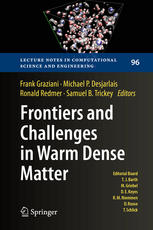

Most ebook files are in PDF format, so you can easily read them using various software such as Foxit Reader or directly on the Google Chrome browser.
Some ebook files are released by publishers in other formats such as .awz, .mobi, .epub, .fb2, etc. You may need to install specific software to read these formats on mobile/PC, such as Calibre.
Please read the tutorial at this link: https://ebookbell.com/faq
We offer FREE conversion to the popular formats you request; however, this may take some time. Therefore, right after payment, please email us, and we will try to provide the service as quickly as possible.
For some exceptional file formats or broken links (if any), please refrain from opening any disputes. Instead, email us first, and we will try to assist within a maximum of 6 hours.
EbookBell Team

4.8
14 reviewsWarm Dense Matter (WDM) occupies a loosely defined region of phase space intermediate between solid, liquid, gas, and plasma, and typically shares characteristics of two or more of these phases. WDM is generally associated with the combination of strongly coupled ions and moderately degenerate electrons, and careful attention to quantum physics and electronic structure is essential. The lack of a small perturbation parameter greatly limits approximate attempts at its accurate description. Since WDM resides at the intersection of solid state and high energy density physics, many high energy density physics (HEDP) experiments pass through this difficult region of phase space. Thus, understanding and modeling WDM is key to the success of experiments on diverse facilities. These include the National Ignition Campaign centered on the National Ignition Facility (NIF), pulsed-power driven experiments on the Z machine, ion-beam-driven WDM experiments on the NDCX-II, and fundamental WDM research at the Linear Coherent Light Source (LCLS). Warm Dense Matter is also ubiquitous in planetary science and astrophysics, particularly with respect to unresolved questions concerning the structure and age of the gas giants, the nature of exosolar planets, and the cosmochronology of white dwarf stars. In this book we explore established and promising approaches to the modeling of WDM, foundational issues concerning the correct theoretical description of WDM, and the challenging practical issues of numerically modeling strongly coupled systems with many degrees of freedom.